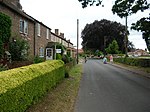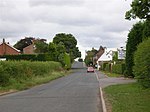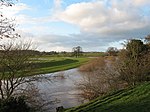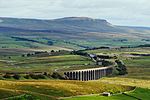Pilmoor railway station
1847 establishments in England1958 disestablishments in EnglandDisused railway stations in North YorkshireFormer North Eastern Railway (UK) stationsPages with no open date in Infobox station ... and 4 more
Railway stations in Great Britain closed in 1958Railway stations in Great Britain opened in 1847Use British English from May 2017Yorkshire and the Humber railway station stubs

Pilmoor railway station was in North Yorkshire, England, from 1847 to 1958, at the junction of the Great North of England Railway and the Pilmoor, Boroughbridge and Knaresborough Railway, about 6 miles (10 km) south-southeast of Thirsk at the southern edge of the civil parish of Sessay. The scattered settlement of Pilmoor (in the civil parish of Brafferton), from which its name was derived, is located southwest of it.
Excerpt from the Wikipedia article Pilmoor railway station (License: CC BY-SA 3.0, Authors, Images).Pilmoor railway station
Race Lane,
Geographical coordinates (GPS) Address Nearby Places Show on map
Geographical coordinates (GPS)
| Latitude | Longitude |
|---|---|
| N 54.1534 ° | E -1.2941 ° |
Address
Pilmoor Junction
Race Lane
YO61 2QG , Sessay
England, United Kingdom
Open on Google Maps











